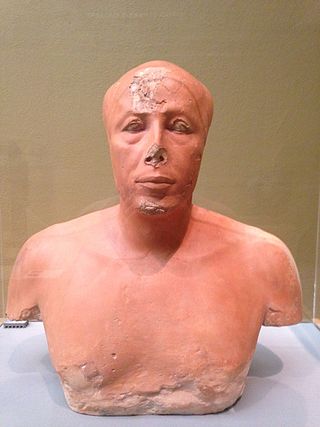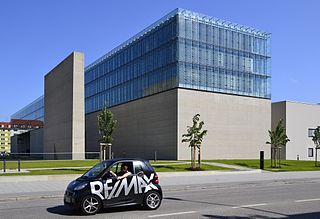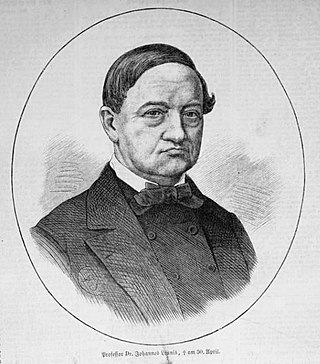
A pyramidion is the capstone of an Egyptian pyramid or the upper section of an obelisk. Speakers of the Ancient Egyptian language referred to pyramidia as benbenet and associated the pyramid as a whole with the sacred benben stone.
Carl Nicholas Reeves, FSA, is a British Egyptologist, archaeologist and museum curator.
Ramses Wissa Wassef (1911–1974) was an Egyptian Coptic architect and professor of art and architecture at the College of Fine Arts in Cairo and founder of the Ramses Wissa Wassef Art Centre.

The painted limestone bust of Ankhhaf is an ancient Egyptian sculpture dating from the Old Kingdom. It is considered the work "of a master" of ancient Egyptian art, and can be seen at the Museum of Fine Arts, Boston. Its catalog number is Museum Expedition 27.442.

The Staatliches Museum Ägyptischer Kunst is an archaeological museum in Munich. It contains the Bavarian state collection of ancient Egyptian art and displays exhibits from both the predynastic and dynastic periods. The associated small Middle East section displays objects from the areas of Assyrian and Babylonian culture. For decades, the Egyptian museum was located in the Munich Residenz, but it was moved to the Kunstareal in June 2013.

The State Museum of Natural History Stuttgart, abbreviated SMNS, is one of the two state of Baden-Württemberg's natural history museums. Together with the State Museum of Natural History Karlsruhe it is one of the most important repositories for state-owned natural history collections.

The Grassi Museum is a building complex in Leipzig, home to three museums: the Ethnography Museum, Musical Instruments Museum, and Applied Arts Museum.

The wall paintings of ancient Thera are famous frescoes discovered by Spyridon Marinatos at the excavations of Akrotiri on the Greek island of Santorini. They are regarded as part of Minoan art, although the culture of Thera was somewhat different from that of Crete, and the political relationship between the two islands at the time is unclear. They have the advantage of mostly being excavated in a more complete condition, still on their walls, than Minoan paintings from Knossos and other Cretan sites.

The Bernward Doors are the two leaves of a pair of Ottonian or Romanesque bronze doors, made c. 1015 for Hildesheim Cathedral in Germany. They were commissioned by Bishop Bernward of Hildesheim (938–1022). The doors show relief images from the Bible, scenes from the Book of Genesis on the left door and from the life of Jesus on the right door. They are considered a masterpiece of Ottonian art, and feature the oldest known monumental image cycle in German sculpture, and also the oldest cycle of images cast in metal in Germany.
Otto Rubensohn was a German-Jewish classical archaeologist.
Marc Erwin Babej is a German–American photographic artist and writer. His elaborately staged works focus on subject matter in history and social science.

The Reiss Engelhorn Museum, is a museum in Mannheim, Germany. It has an exhibition area of 11,300 square metres (122,000 sq ft), and houses around 1.2 million objects.

The Mastaba of Seshemnefer IV is a mastaba tomb in Cemetery GIS of the Giza Necropolis in Egypt. It dates from the early Sixth Dynasty, and was built for the official Seshemnefer IV. Five reliefs from the mastaba of Seshemnefer IV are on display in the Egyptian collection of the Roemer- und Pelizaeus-Museum Hildesheim.
Henning Franzmeier is a German archaeologist and Egyptologist with the Roemer- und Pelizaeus-Museum Hildesheim and University College London (UCL). Taking over from Edgar B. Pusch he has been field director of the "Qantir-Piramesse Project" in Egypt's Nile Delta since 2015, where Pi-Ramesses, the capital of Ramesside Egypt is being unearthed.

Kaethe Katrin Wenzel is a German artist. Her works are about Utopian ideas, the future, and alternative concepts for society. Her main instruments are drawing, interviews, the Internet, mechanics/electronics, and street art. She uses techniques from surveys to speculative fiction to explore "the collective production of culture, the interface of art and science, and the production and negotiation of public space".

Katja Lembke is a German classical archaeologist and Egyptologist and director of the Lower Saxony State Museum in Hanover.

Johannes Matthias Joseph Leunis was a German clergyman, naturalist and botanist. He was a co-founder of the Roemer Museum in Hildesheim.
Rainer Hannig was a German Egyptologist.

















